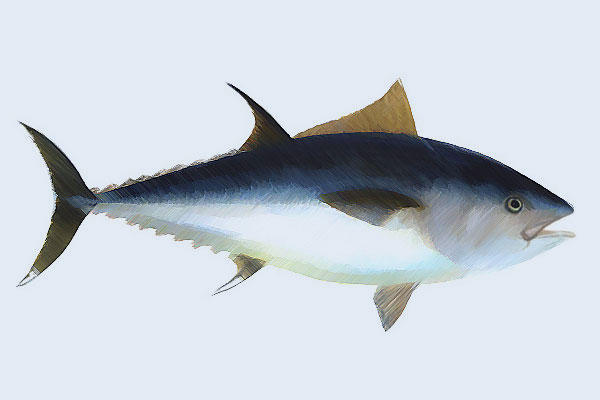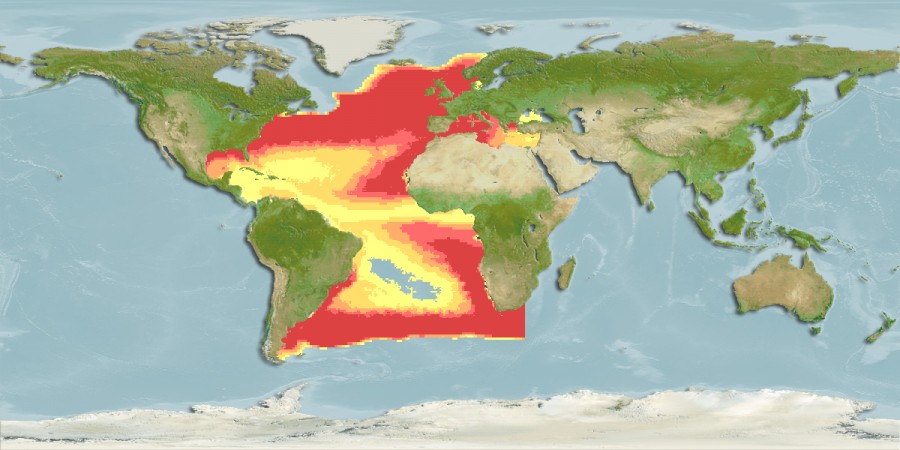Tuna
Classification / Names
Actinopterygii (Ray-finned fishes) > Perciformes (Perch-likes) > Scombridae (Mackerels, tunas, bonitos) > Scombrinae

Size / Weight / Age
Max length: 458 cm
Common length: 200 cm
Max published weight: 684.0 kg
Max reported age: 15 years
Environment
Pelagic-oceanic; oceanodromous; marine; brackish; depth range 0 – 985 m, usually 0 – 100 m
Climate / Range
Subtropical; 72°N – 58°S, 99°W – 42°E
Description
Five of the 13 species of tuna are marketed commercially in the U.S. They are albacore, yellowfin, bluefin, bigeye and skipjack. Bonito is a small tuna, marketed as bonito because its quality is less than that of other tunas.
Albacore
(Thunnus alalunga) is the only canned tuna that can be called "white meat tuna." Market weight is 10 to 30 pounds. Meat is light red to pink but turns white when cooked. Albacore is caught mostly in the Pacific, off the West Coast and Hawaii. In Hawaii, it is known as tombo.
Yellowfin
(T. albacares) is named for its bright-yellow dorsal and anal fins and the stripe of yellow on its sides. Its meat is somewhat darker than albacore and it is usually cheaper than bluefin or bigeye in the market. It is called ahi in Hawaii. Yellowfin runs from 209 to 100 pounds but can grow as large as 400 pounds. It is used mostly in canning.
Bluefin
(T. thynnus) is the largest of the tunas, sometimes reaching 1,500 pounds. A bluefin is steel-blue with medium-red to deep-red or brown meat, depending on the size. Most tuna are under 150 pounds when they are harvested. They migrate up the Atlantic Coast from South America to New England.
Bigeye
(T. obesus) tuna has lighter meat than bluefin. In the earlier part of the harvest season, bigeye has the higher fat content desired by the Japanese market and usually brings a better price. Most weigh between 50 and 150 pounds, though they can grow to 400 pounds.
Skipjack
(Euthunnus pelamis) has darker meat than yellowfin and is mostly used in canning. It is not usually sold fresh in the U.S. but is exported to Japan. In Canada, it is sold as oceanic bonito or arctic bonito. In Hawaii, it is called aku.
Bluefin
(T. thynnus) is the largest of the tunas, sometimes reaching 1,500 pounds. A bluefin is steel-blue with medium-red to deep-red or brown meat, depending on the size. Most tuna are under 150 pounds when they are harvested. They migrate up the Atlantic Coast from South America to New England.
Distribution
Western Atlantic: Canada, Gulf of Mexico, and the Caribbean Sea to Venezuela and Brazil. Eastern Atlantic: Lofoten Islands off Norway to Canary Islands, including the Mediterranean and the southern part of the Black Sea (Ref. 6769). Reported from Mauritania (Ref. 5377). There is a subpopulation off South Africa. Highly migratory species, Annex I of the 1982 Convention on the Law of the Sea (Ref. 26139).
